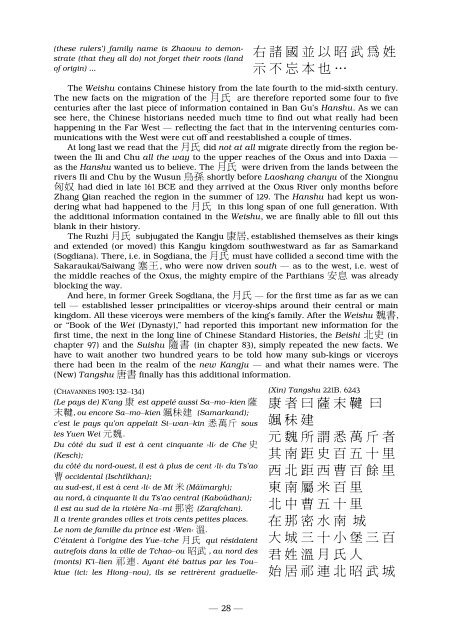張騫 Zhang Qian. The Secret Envoy of Han Emperor Wu in Search of the Arsi (Yuezhi) and the Fall of the Græco-Bactrian Kingdom. (Annotated Compilation of Eastern and Western Sources)
The study undertakes: — to clarify in what year Zhang Qian reached the Oxus river; to establish that the Daxia 大夏 in Shiji 123 represent the Tachar/Tochar of Tochar-i-stan; to explain how we are to understand the "List of Four" in Strabon 11.8.2.
The study undertakes: —
to clarify in what year Zhang Qian reached the Oxus river;
to establish that the Daxia 大夏 in Shiji 123 represent the Tachar/Tochar of Tochar-i-stan;
to explain how we are to understand the "List of Four" in Strabon 11.8.2.
You also want an ePaper? Increase the reach of your titles
YUMPU automatically turns print PDFs into web optimized ePapers that Google loves.
(<strong>the</strong>se rulers’) family name is Zhaowu to demon-<br />
strate (that <strong>the</strong>y all do) not forget <strong>the</strong>ir roots (l<strong>and</strong><br />
<strong>of</strong> orig<strong>in</strong>) ...<br />
右 諸 國 並 以 昭 武 為<br />
示 不 忘 本 也 …<br />
姓<br />
<strong>The</strong> Weishu conta<strong>in</strong>s Ch<strong>in</strong>ese history from <strong>the</strong> late fourth to <strong>the</strong> mid-sixth century.<br />
<strong>The</strong> new facts on <strong>the</strong> migration <strong>of</strong> <strong>the</strong> 月 氏 are <strong>the</strong>refore reported some four to five<br />
centuries after <strong>the</strong> last piece <strong>of</strong> <strong>in</strong>formation conta<strong>in</strong>ed <strong>in</strong> Ban Gu’s <strong>Han</strong>shu. As we can<br />
see here, <strong>the</strong> Ch<strong>in</strong>ese historians needed much time to f<strong>in</strong>d out what really had been<br />
happen<strong>in</strong>g <strong>in</strong> <strong>the</strong> Far West — reflect<strong>in</strong>g <strong>the</strong> fact that <strong>in</strong> <strong>the</strong> <strong>in</strong>terven<strong>in</strong>g centuries com-<br />
<strong>of</strong>f <strong>and</strong> reestablished a couple <strong>of</strong> times.<br />
munications with <strong>the</strong> West were cut<br />
At long last we read that <strong>the</strong> 月 氏 did not at all migrate directly from <strong>the</strong> region be-<br />
reaches <strong>of</strong> <strong>the</strong> Oxus <strong>and</strong> <strong>in</strong>to Daxia —<br />
tween <strong>the</strong> Ili <strong>and</strong> Chu all <strong>the</strong> way to <strong>the</strong> upper<br />
as <strong>the</strong> <strong>Han</strong>shu wanted us to believe. <strong>The</strong> 月 氏 were driven from <strong>the</strong> l<strong>and</strong>s between <strong>the</strong><br />
rivers Ili <strong>and</strong> Chu by <strong>the</strong> <strong>Wu</strong>sun 烏 孫 shortly<br />
before Laoshang chanyu <strong>of</strong> <strong>the</strong> Xiongnu<br />
匈 奴 had died <strong>in</strong> late 161 BCE <strong>and</strong> <strong>the</strong>y arrived at <strong>the</strong> Oxus River only months before<br />
<strong>Zhang</strong> <strong>Qian</strong> reached <strong>the</strong> region <strong>in</strong> <strong>the</strong> summer <strong>of</strong> 129. <strong>The</strong> <strong>Han</strong>shu had kept us won-<br />
long span <strong>of</strong> one full generation. With<br />
der<strong>in</strong>g what had happened to <strong>the</strong> 月 氏 <strong>in</strong> this <strong>the</strong> additional <strong>in</strong>formation conta<strong>in</strong>ed <strong>in</strong> <strong>the</strong> Weishu, we are f<strong>in</strong>ally able to fill out this<br />
blank <strong>in</strong> <strong>the</strong>ir history.<br />
<strong>The</strong> Ruzhi 月 氏 subjugated <strong>the</strong> Kangju 康 居 , established <strong>the</strong>mselves as <strong>the</strong>ir k<strong>in</strong>gs<br />
<strong>and</strong> extended (or moved) this Kangju k<strong>in</strong>gdom southwestward as far as Samark<strong>and</strong><br />
(Sogdiana). <strong>The</strong>re, i.e. <strong>in</strong> Sogdiana, <strong>the</strong> 月 氏 must have collided a second time with <strong>the</strong><br />
Sakaraukai/Saiwang 塞 王 , who were now dri<br />
ven south — as to <strong>the</strong> west, i.e. west <strong>of</strong><br />
<strong>the</strong> middle reaches <strong>of</strong> <strong>the</strong> Oxus, <strong>the</strong> mighty empire <strong>of</strong> <strong>the</strong> Parthians 安 息 was already<br />
block<strong>in</strong>g <strong>the</strong> way.<br />
And here, <strong>in</strong> former Greek Sogdiana, <strong>the</strong> 月 氏 — for <strong>the</strong> first time as far as we can<br />
tell — established lesser pr<strong>in</strong>cipalities or viceroy-ships around <strong>the</strong>ir central or ma<strong>in</strong><br />
k<strong>in</strong>gdom. All <strong>the</strong>se viceroys were members <strong>of</strong> <strong>the</strong> k<strong>in</strong>g’s family. After <strong>the</strong> Weishu 魏 書 ,<br />
or “Book <strong>of</strong> <strong>the</strong> Wei (Dynasty),” had reported this important new <strong>in</strong>formation for <strong>the</strong><br />
first time, <strong>the</strong> next <strong>in</strong> <strong>the</strong> long l<strong>in</strong>e <strong>of</strong> Ch<strong>in</strong>ese St<strong>and</strong>ard Histories, <strong>the</strong> Beishi 北 史 (<strong>in</strong><br />
chapter 97) <strong>and</strong> <strong>the</strong> Suishu 隨 書 (<strong>in</strong> chapter 83), simply repeated <strong>the</strong> new facts. We<br />
have to wait ano<strong>the</strong>r two hundred years to be told how many sub-k<strong>in</strong>gs or viceroys<br />
<strong>the</strong>re had been <strong>in</strong> <strong>the</strong> realm <strong>of</strong> <strong>the</strong> new Kangju — <strong>and</strong> what <strong>the</strong>ir names were. <strong>The</strong><br />
(New) Tangshu 唐 書 f<strong>in</strong>ally has this additional <strong>in</strong>formation.<br />
(CHAVANNES 1903: 132–134)<br />
(Le pays de) K’ang 康 est appelé aussi Sa–mo–kien 薩<br />
末 鞬 , ou encore Sa–mo–kien 颯 秣 建 (Samark<strong>and</strong>);<br />
c’est le pays qu’on appelai t Si–wan–k<strong>in</strong> 悉 萬 斤 sous<br />
les Yuen Wei 元 魏 .<br />
Du côté du sud il est à cent c<strong>in</strong>quante ›li‹ de Che 史<br />
(Kesch);<br />
du côté du nord-ouest, il est à plus de cent ›li‹ du Ts’ao<br />
曹 occidental (Ischtîkhan);<br />
au sud-est, il est à cent ›li‹ de Mi 米 (Mâïmargh);<br />
au nord, à c<strong>in</strong>quante li du Ts’ao central (Kaboûdhan);<br />
il est au sud de la rivière Na–mi 那 密 (Zara fchan).<br />
Il a trente gr<strong>and</strong>es villes et trois cents petites places.<br />
Le nom de famille du pr<strong>in</strong>ce est ›Wen‹ 溫 .<br />
C’étaient à l’orig<strong>in</strong>e des Yue–tche 月 氏 qui résidaient<br />
autrefois dans la ville de Tchao–ou 昭 武 , au nord des<br />
(monts) K’i–lien 祁 連 . Ayant été battus par les Tou–<br />
kiue (ici: les Hiong–nou), ils se retirèrent graduelle-<br />
(X<strong>in</strong>) Tangshu 221B. 6243<br />
康 者 曰 薩 末 鞬 曰<br />
颯 秣 建<br />
元 魏 所 謂 悉 萬 斤 者<br />
其 南 距 史 百 五 十 里<br />
西 北 距 西 曹 百 餘 里<br />
東 南 屬 米 百 里<br />
北 中 曹 五 十 里<br />
在 那 密 水 南 城<br />
大 城 三 十 小 堡 三 百<br />
君 姓 溫 月 氏 人<br />
始 居 祁 連 北 昭 武 城<br />
— 28 —


